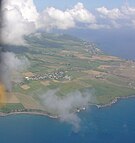Saint Kitts and Nevis

The Federation of Saint Kitts and Nevis, located in the Leeward Islands is a unitary island nation in the Caribbean. The capital-city and government for the federated state, is mainly on the larger island of, Saint Kitts (formerly named: Saint Christopher). The smaller state of Nevis (formerly named: Nuestra Señora de las Nieves) lies about 3km southeast of Saint Kitts. Historically the British dependency of Anguilla was also a part of this union, which was then known collectively as Saint Christopher-Nevis-Anguilla.
Given that Saint Kitts and Nevis are geographically within the Leeward Islands, they are relatively close to a cluster of several other islands. To the north-north west lies the islands of Anguilla, Saba, Saint Barthélemy and Saint Martin. To the north-east lies Antigua and Barbuda. To the south-east lies Montserrat and the to west, lies Saint Croix.
History
Main article: History of Saint Kitts and Nevis
Originally colonies of the United Kingdom, Saint Kitts and Nevis along with Anguilla, became an associated state with full internal autonomy in 1967. Anguilla rebelled and was allowed to secede in 1971. St. Kitts and Nevis achieved independence in 1983. In August 1998, a vote in Nevis on a referendum to separate from St. Kitts fell short of the two-thirds majority needed. In late September 1998, Hurricane Georges caused approximately $445 million in damages and limited GDP growth for the year.
Alexander Hamilton, the first United States Secretary of the Treasury, was born on Nevis and spent his childhood there and on the island of St. Croix.
Politics
Main article: Politics of Saint Kitts and Nevis
The country is an independent Commonwealth Realm with Queen Elizabeth II as its head of state, represented in St. Kitts and Nevis by a governor general, who acts on the advice of the Prime Minister and the cabinet. The prime minister is the leader of the majority party of the house, and the cabinet conducts affairs of state.
St. Kitts and Nevis has a unicameral legislature, known as the National Assembly. It is comprised of fourteen members - eleven elected representatives - three of whom are from the island of Nevis - and three members who are appointed by the Governor-General. The three appointed members are known as Senators, with two being appointed on the advice of the Prime Minister, and one on the advice of the leader of the opposition. Though they are referred to as Senators, they do not form a separate house of parliament, as in some other countries. Both representatives and senators serve five-year terms. The prime minister and the cabinet are responsible to the Parliament.
Saint Kitts and Nevis are a full & participating member of the Caribbean Community (CARICOM) and the Organisation of Eastern Caribbean States (OECS).
Parishes
There are fourteen parishes:
- Christ Church Nichola Town
- Saint Anne Sandy Point
- Saint George Basseterre
- Saint George Gingerland - N
- Saint James Windward - N
- Saint John Capisterre
- Saint John Figtree - N
- Saint Mary Cayon
- Saint Paul Capisterre
- Saint Paul Charlestown - N
- Saint Peter Basseterre
- Saint Thomas Lowland - N
- Saint Thomas Middle Island
- Trinity Palmetto Point
- N - denotes a parish on the island of Nevis.
Geography

Main article: Geography of Saint Kitts and Nevis
The country has two main islands, Saint Kitts and Nevis. The highest peak is Mount Liamuiga, which tops at 1 156 m.
Economy
Main article: Economy of Saint Kitts and Nevis
Saint Kitts and Nevis was the last sugar monoculture in the Eastern Caribbean. Faced with a sugar industry that was finding it increasingly difficult to earn a profit, the Government of St. Kitts and Nevis embarked on a program to diversify the agricultural sector and stimulate the development of other sectors of the economy.
Demographics
Main article: Demographics of Saint Kitts and Nevis
As of July 2000, there were 38 819 inhabitants; their average life expectancy was 70.73 years. Emigration has historically been very high, and the population is about 25% lower than at its peak of about 51,100 in 1960.
Culture
Main article: Culture of Saint Kitts and Nevis
